Japan began testing a railgun on a mother ship
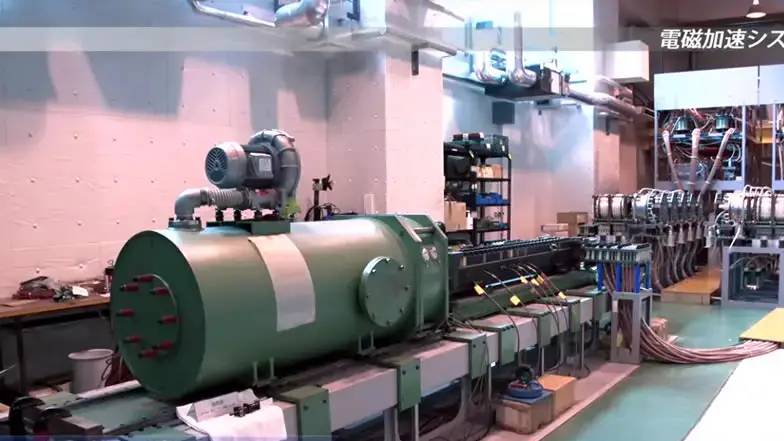
Experimental rail gun mod. 2018
In order to increase the firepower of naval artillery, the Japanese military industry is developing a promising electromagnetic gun. To date, this project has reached the stage of implementation in metal. A few months ago, the finished weapon was presented, and now it has been installed on the carrier ship and the first fire tests have been carried out. It is expected that such events will continue and show the full potential of the new design.
Sequence of projects
According to known data, the Japanese railgun gun development program started back in 1990 at the initiative of the Technology, Acquisition and Logistics Agency (ATLA) of the Ministry of Defense. Research and preliminary design work in this direction were carried out by the Agency's Ground Systems Research Center.
The program was highly complex, which affected the pace of work. Only in the 16s and XNUMXs was it possible to bring the first version of the technology demonstrator gun to testing. It had a caliber of XNUMX mm and showed limited energy and fire characteristics. Nevertheless, the fundamental possibility of creating such a design was confirmed.
In 2016, the ATLA Ground Systems Research Center began creating a new bench prototype in a larger caliber with improved performance. The finished sample was demonstrated in 2018. At the same time, it underwent fire tests, which confirmed the correctness of the design solutions.

Prototype arr. 2023[/ Center]
Then the design of a full-fledged artillery installation began, intended for testing on a carrier ship. This project was completed no later than 2021-22. In May 2022, the Ground Systems Research Center commissioned Japan Steel Works to manufacture a pilot plant. The construction of this product was estimated at 6,5 billion yen (approx. $48 million).
The order took a year to complete. In mid-May 2023, the contractor demonstrated the gun on a machine, ready for testing. In the near future they planned to put it on the carrier and conduct the first firing. It was reported that the gun has a caliber of 40 mm and should show a muzzle energy of 5 MJ.
Cannon on a ship
Within a few months, the prototype was prepared for testing on the water. On October 17, ATLA reported the first firing of an electromagnetic gun located on a combat ship of the Maritime Self-Defense Forces. It is claimed that this is the world's first testing of such a product on a surface platform.
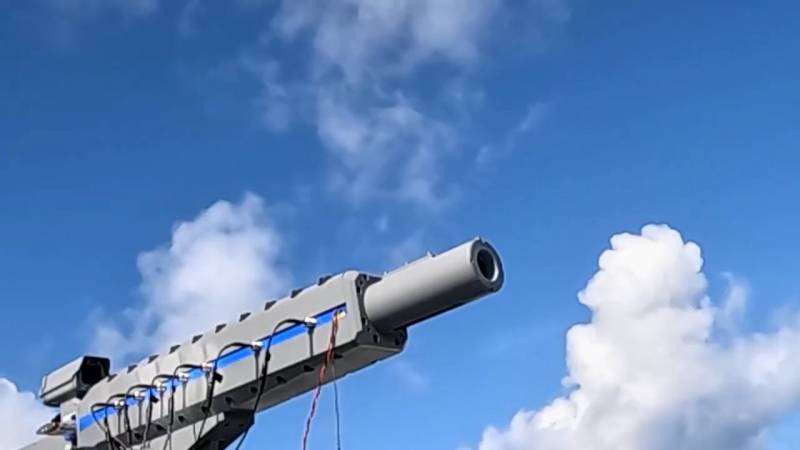
Gun on recent tests
ATLA included a short demonstration video with the official announcement. It shows the firing of a new gun from different angles. It is not reported how many shots were fired during the test. At the same time, some of the main characteristics were named, showing the general capabilities of the gun.
It is reported that the new artillery installation is designed to protect its carriers and warrant ships from surface and air threats. They will be fought with high-speed projectiles from electromagnetic weapons. ATLA intends to do everything possible to complete the work as quickly as possible and bring the weapon into service.
Technical issues
To date, ATLA and Japan Steel Works have revealed the appearance of the experimental railgun artillery mount, and also published some of its characteristics. At the same time, a significant part of technical data remains closed. However, it is possible to imagine the appearance and features of the gun, as well as determine its approximate potential.
In official reports, the experimental product is called a “rail gun,” which indicates the general features of its design and principle of operation. The main element of such a system is a pair of parallel rails on which the projectile is located, either itself or in a detachable tray. A current is supplied to the rails, creating a magnetic field on them. In this case, an Ampere force is created on the projectile that closes the circuit, leading to its acceleration and firing.
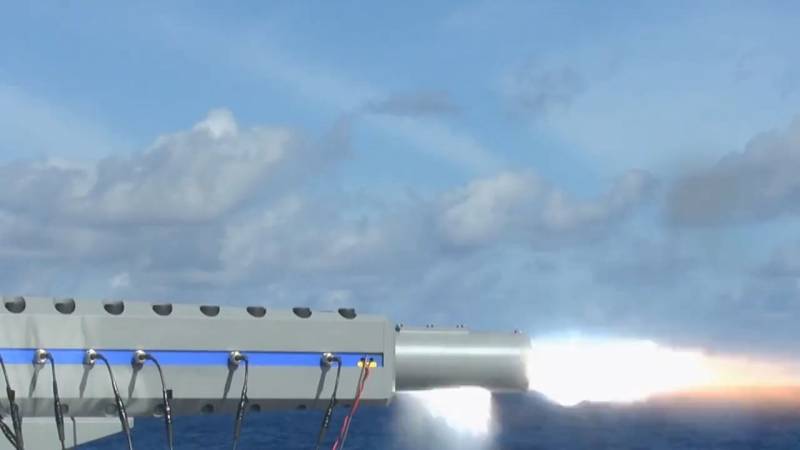
Shot
It should be noted that the appearance of the Japanese experimental gun does not allow us to determine its class and principle of operation. All key elements are covered with casings, and there are also various cables and a cylindrical muzzle, which could be considered a sign of the use of a Gaussian circuit.
The exterior of the prototype is probably formed by removable casings and hides key components. So, in May, an experimental gun was shown with a full set of additional panels. In this configuration, it looked like an elongated parallelepiped with a hole in the front wall and a breech in the rear. During fire tests, the covers were probably removed. However, even after this, the key parts remained inside the case, hiding all the details.
The gun is placed on the swinging part of the machine with vertical aiming mechanisms. Obviously, the artillery system includes not only the cannon itself. It needs electronic controls, a power system with sufficient performance, etc.
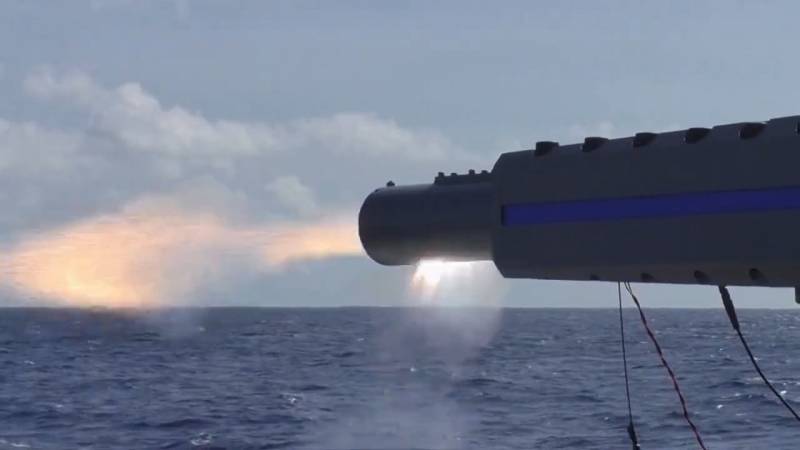
Reportedly, the current version of the ATLA gun has a caliber of 40 mm. Special projectiles weighing 320 g with a detachable metal tray are used. The initial speed of such a blank can reach 2230 m/s, the muzzle energy is 5 MJ. It is reported that the product is not yet using its full energy potential. As testing continues and characteristics increase, the muzzle energy is going to be increased to 20 MJ.
The range of aimed fire, the penetration characteristics of the projectile and other features of the new system are not specified. At the same time, it has been repeatedly reported that in all main parameters the railgun is superior to existing powder systems, even of larger calibers.
Prospects for Directions
The platform for testing the experimental rail gun was one of the Japanese MSS warships, although its type and name were not named. For an indefinite period of time, he will have to ensure testing and testing of the new design, based on the results of which the command will draw conclusions and determine the future fate of the project.
If the tests that have begun confirm the design characteristics, then the Japanese fleet will be able to receive a fundamentally new weapon. The most likely carriers of railguns are destroyers of the latest and future projects. They have a modern high-power power plant, which should be enough to ensure the operation of a fundamentally new weapon.
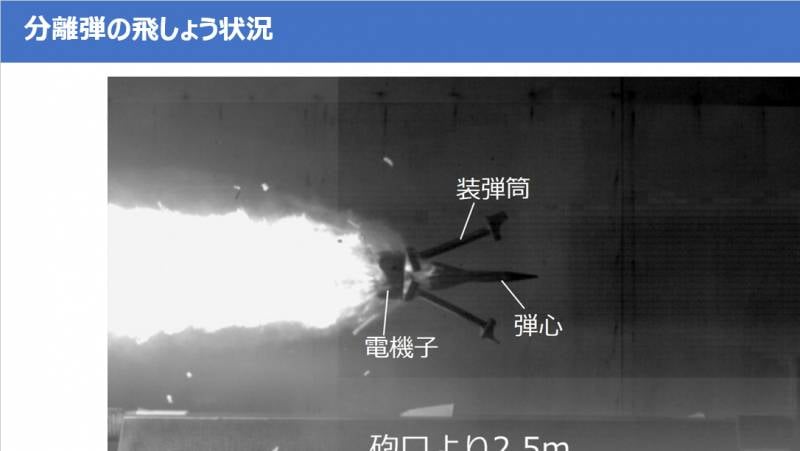
Separation of projectile and master device
The rail gun being tested has a caliber of only 40 mm and should produce a muzzle energy of 20 MJ. It can be assumed that MCC and ATLA will not stop there and will begin to scale the new technology. The result of this over the next few years may be new models of guns with higher performance. The caliber, projectile weight, firing range, etc. will be increased.
However, such development of this direction directly depends on the energy capabilities of existing and future ships. There is no point in creating a weapon whose energy consumption will exceed the generation of any existing and future platforms. In addition, the complexity and high cost of such a weapon mount calls into question the need for constant improvement of performance.
In a narrow circle
Thus, Japan entered an extremely narrow circle of countries that not only deal with the subject of electromagnetic weapons, but also managed to bring such a product to testing on a surface platform. ATLA and related organizations recently began testing their railgun in a real-world configuration.
It is unknown what the results of these measures will be. The program developers are very optimistic and hope for positive results. If their expectations are met, then the MSS will be able to obtain a fundamentally new weapon. However, the timing of completing all work and putting the guns into service is still in question.
Information